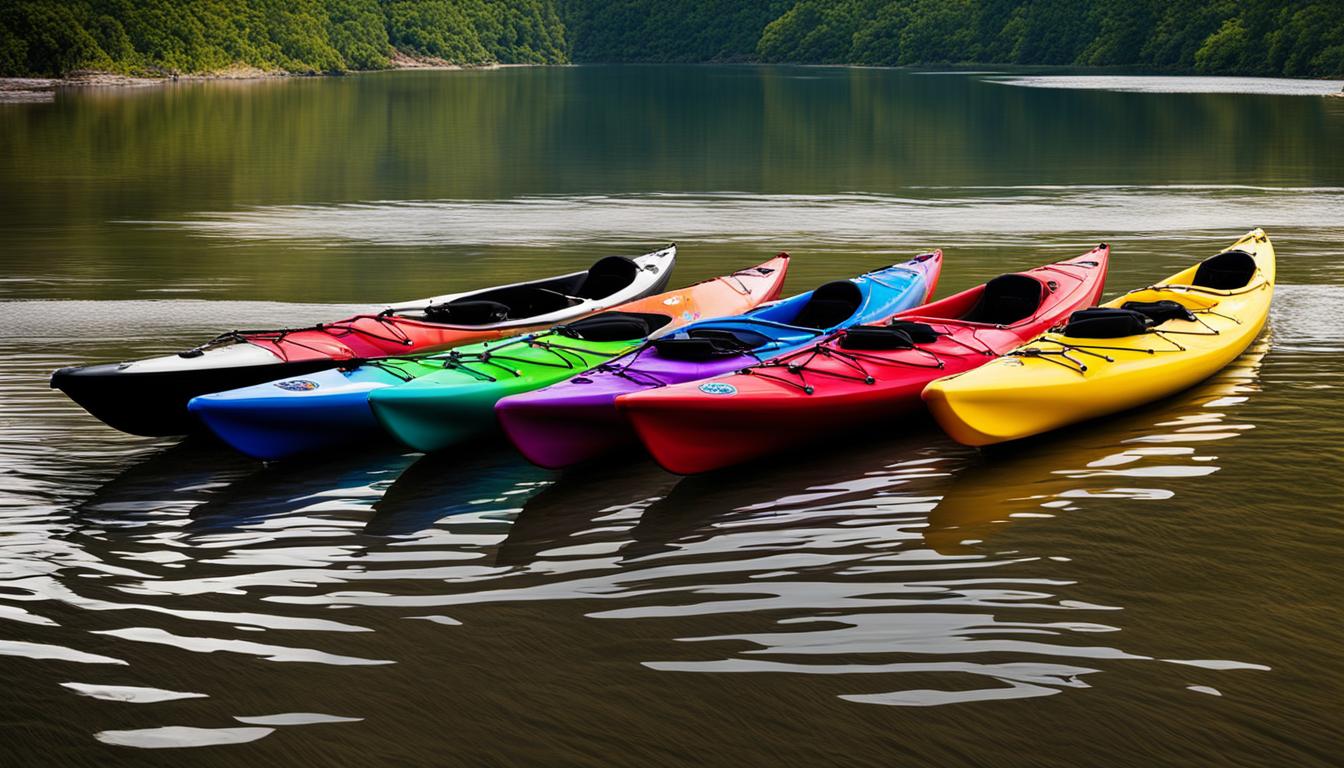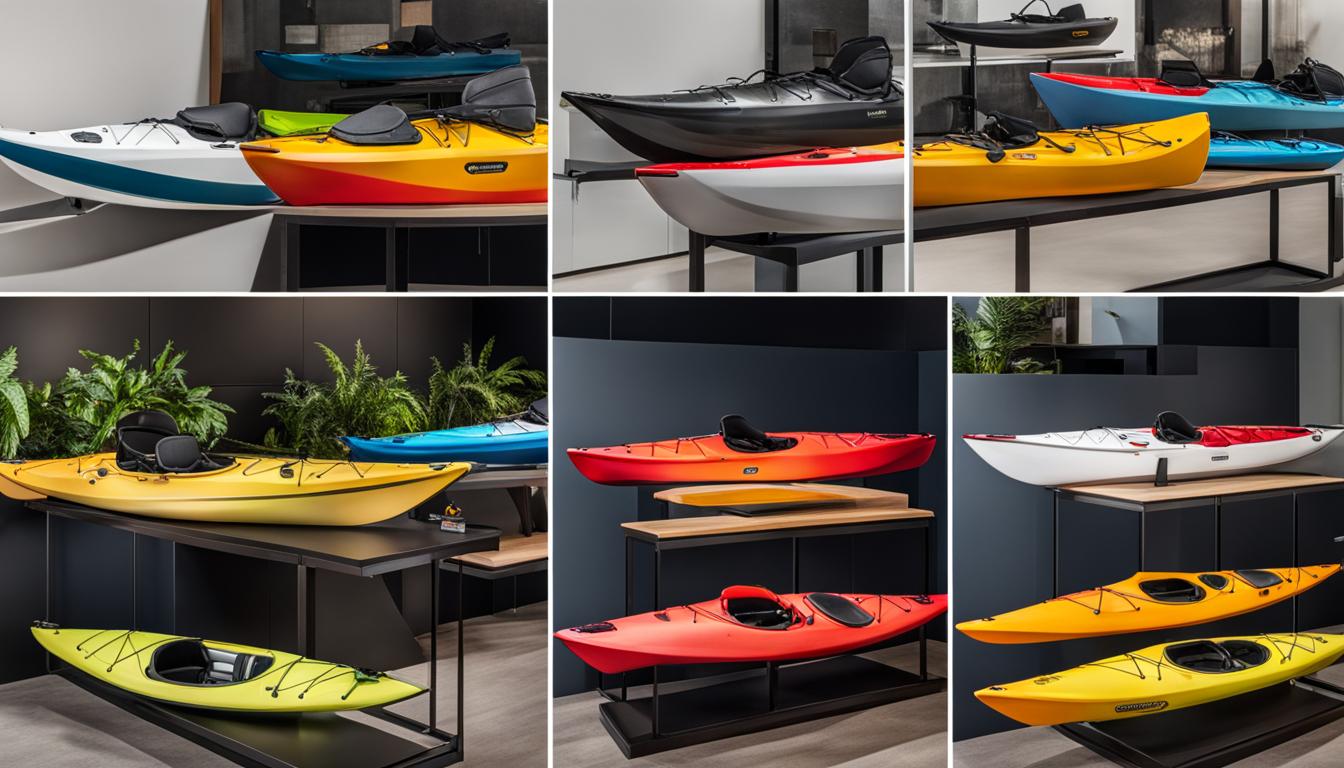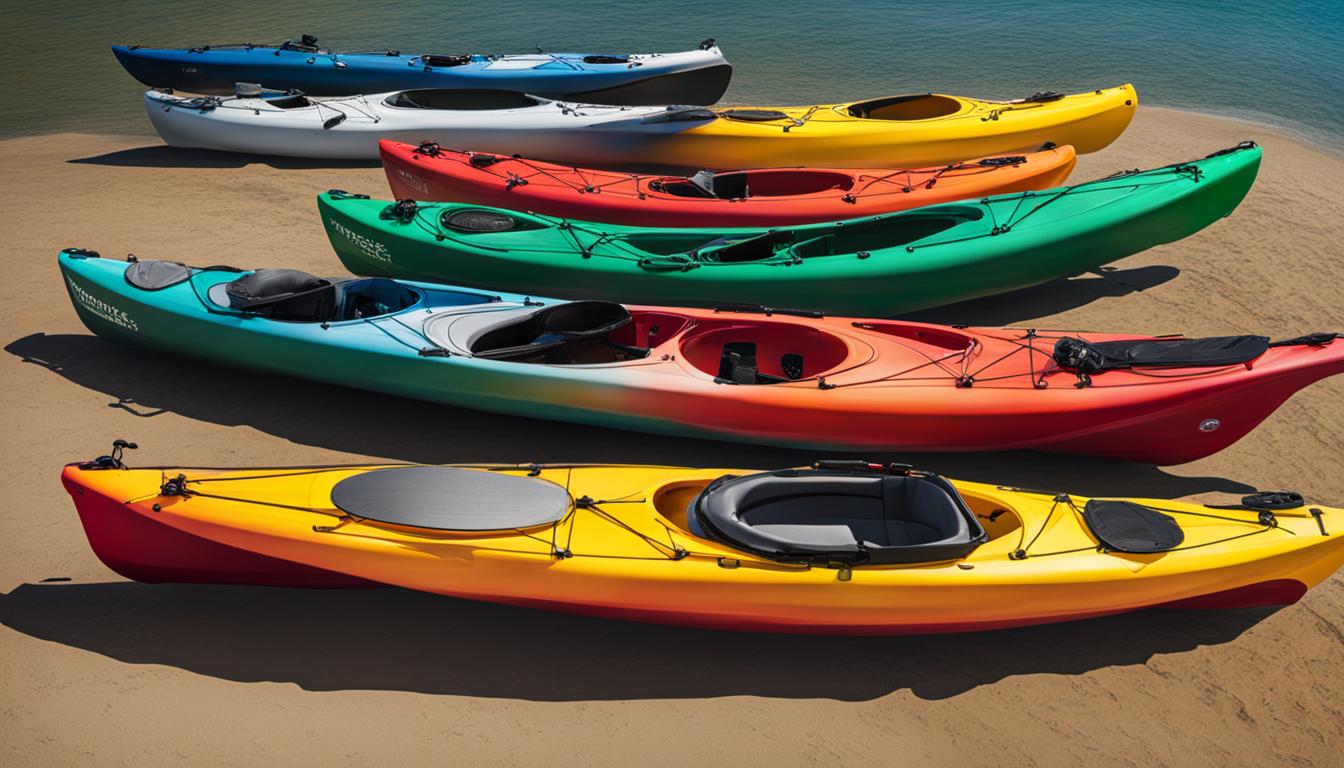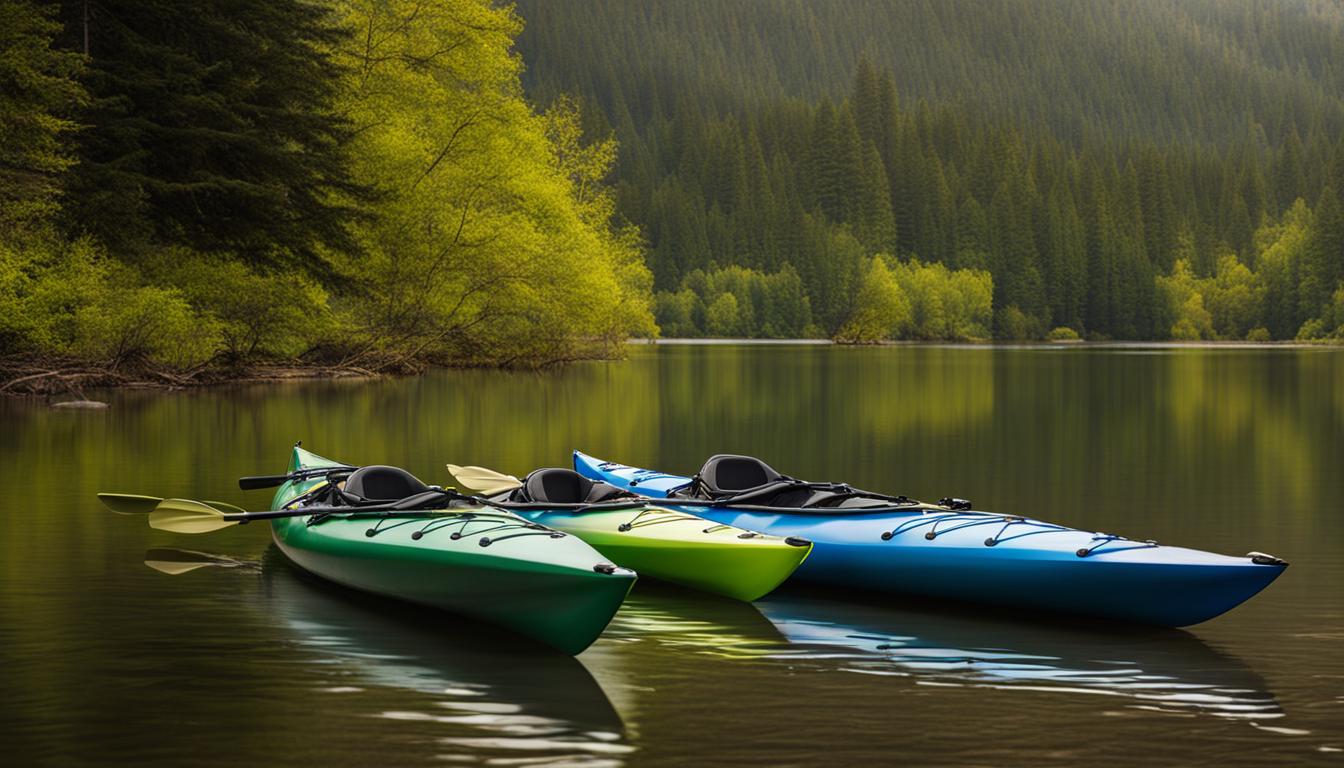When it comes to professional whitewater kayaks, it’s important to consider the prices and options available. Whether you’re a seasoned paddler or just starting out, understanding the cost of professional kayaks can help you make an informed decision.
Prices for professional whitewater kayaks can vary based on factors such as whether you choose new or used gear. If you’re on a budget, you can find a used starter kit, including a kayak, paddle, skirt, and personal flotation device (PFD), for around $700. For those who prefer to buy individual items, used kayaks are priced at around $500, helmets at $40, PFDs at $50, drytops at $100, paddles at $150, and sprayskirts at $50.
If you’re looking to invest in new gear, the price range will be higher. Expect to pay around $2,500 for all the necessary equipment. New paddles can range from $200 to $400, drytops will cost approximately $400, sprayskirts around $200, PFDs about $130, and helmets $80. The most significant investment will be a new kayak, with prices for top models like Jackson kayaks starting at $1,400. Keep in mind that financing options are available to help make the investment more manageable.
Key Takeaways:
- Professional whitewater kayaks vary in price, depending on whether you choose new or used gear.
- A used starter kit can be found for around $700, while individual used items can be purchased separately.
- New gear can cost approximately $2,500, with the most expensive item being a new kayak.
- Consider financing options to make the investment more manageable.
- Make sure to weigh the benefits of new versus used gear, taking into account warranties and updated technology.
Necessities for Whitewater Kayaking
To get started in whitewater kayaking, there are a few essential pieces of gear you’ll need. These items ensure your safety and enhance your kayaking experience. Whether you’re a beginner or an experienced paddler, having the right equipment is crucial. Here are the must-have kayak accessories:
Helmets
Protecting your head is of utmost importance when kayaking in rapids and turbulent waters. A sturdy and well-fitted helmet will shield you from potential dangers and impacts. Look for helmets specifically designed for whitewater kayaking, with adjustable straps and foam padding for a secure and comfortable fit.
Personal Flotation Devices (PFDs)
A PFD, also known as a life jacket, is an essential safety item for kayakers. It keeps you afloat and provides buoyancy in case of an accident or capsize. Ensure that your PFD is Coast Guard-approved and fits snugly. Opt for PFDs specifically designed for whitewater kayaking, which offer a higher buoyancy rating and additional safety features.
Drytops/Drysuits
Whitewater kayaking involves getting wet, and staying dry is key to staying warm and comfortable. A drytop or drysuit is designed to keep water out while allowing moisture to escape. Depending on the water temperature and your preference, choose between a drytop, which covers your upper body, or a full drysuit, which provides complete coverage.
Sprayskirts
A sprayskirt is a cover that seals the cockpit of your kayak, preventing water from entering. It keeps you dry and improves maneuverability by maintaining contact between you and the boat. Look for a sprayskirt that fits the cockpit of your kayak snugly and has a reliable sealing mechanism, such as a neoprene or rubber rand.
Paddles
A kayak paddle is your engine in the water, so it’s essential to choose one that suits your paddling style and preferences. Paddles come in various materials, lengths, and blade shapes. Consider your strength, the type of whitewater kayaking you’ll be doing, and your budget when selecting a paddle.
Additional Items
Aside from the essentials mentioned above, there are a few additional items that can enhance your whitewater kayaking experience. These include baselayers, which provide insulation and moisture-wicking properties, booties to protect your feet, a throw rope for rescue purposes, nose plugs to keep water out of your nasal passages, float bags for added buoyancy, and a whistle to attract attention if needed.
Used gear can be a cost-effective option, but be cautious when buying second-hand items. Make sure they are in good condition and suitable for your skill level. Consider joining local whitewater forums or checking platforms like Facebook Marketplace and Craigslist for used gear. It’s crucial to prioritize safety and invest in high-quality gear that meets your specific needs.
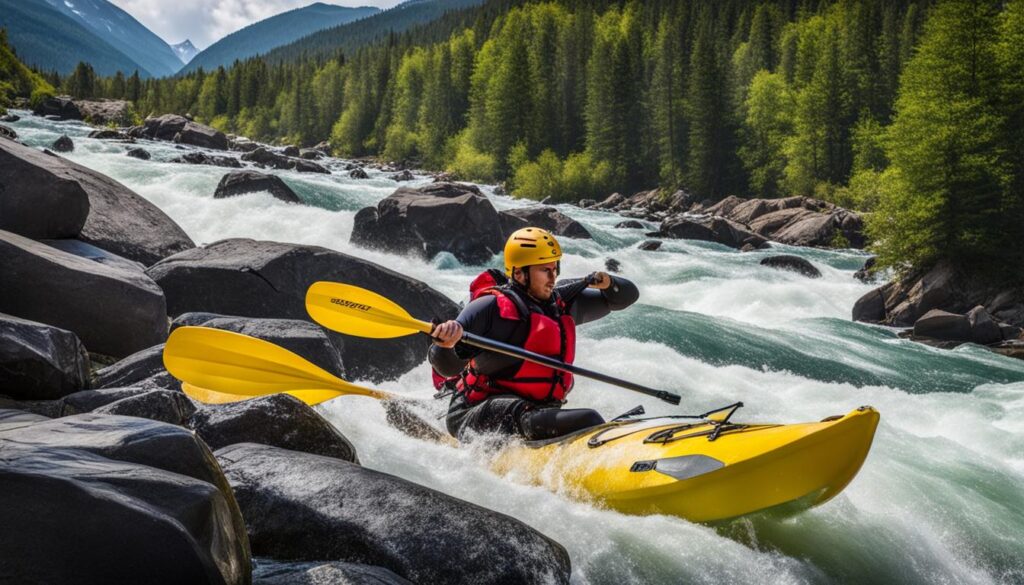
Understanding Kayak Costs by Type
When it comes to professional whitewater kayaks, prices can vary significantly depending on the type of kayak you choose. Understanding the different kayak types and their associated costs can help you make an informed decision when purchasing your gear.
Creek Boats
Creek boats are the largest and most stable type of whitewater kayak. They are designed for navigating through fast-moving water and handling challenging rapids. Creek boats typically range from 7.5 to 10 feet in length and can cost around $1,000. These kayaks are built to withstand impact and provide stability in turbulent conditions, making them a popular choice among experienced paddlers.
Slicey Boats
Slicey boats are known for their versatility and maneuverability. They are designed to carve and surf in smaller and less powerful features, making them ideal for freestyle and playboating. Slicey boats usually range from 7 to 9 feet in length and have a similar price range to creek boats. These kayaks offer a balance between stability and agility, allowing paddlers to execute precise moves on the water.
Playboats
Playboats are the shortest type of whitewater kayak and are specifically designed for performing tricks and aerial maneuvers. They are highly maneuverable and responsive, enabling paddlers to play and surf in various whitewater features. Playboats range from 6 to 8 feet in length and come in a wide price range. While longer playboats can cost around $1,000, shorter playboats can be found for less.
| Kayak Type | Length Range | Price Range |
|---|---|---|
| Creek Boats | 7.5 – 10 feet | $1,000 |
| Slicey Boats | 7 – 9 feet | Similar to creek boats |
| Playboats | 6 – 8 feet | Varies depending on length |
Understanding the cost range for different types of kayaks can help you budget and choose the right kayak for your whitewater adventures. Consider your skill level, the type of whitewater you plan to tackle, and your preferred paddling style when making your kayak selection.
Considering Kayak Hull Types
When it comes to whitewater kayaks, one important decision to make is choosing the right hull type. There are two main options: planing hull and displacement hull. Each has its own characteristics and benefits, so it’s essential to understand the differences before making a choice.
Planing Hull
The planing hull is characterized by a flat bottom with sharp edges. This design allows the kayak to skim and ride on top of the water, making it easier to turn and maneuver. Planing hulls are often preferred by experienced kayakers who enjoy surfing and playing in dynamic water conditions. The flat bottom also provides more stability when surfing a wave or running rapids. However, the downside is that planing hulls can be less stable in calm, flatwater situations.
Displacement Hull
On the other hand, a displacement hull features a rounded bottom with smooth edges. This design allows the kayak to displace water and create a more efficient, smoother ride. Displacement hulls are known for their ability to track well in a straight line, making them ideal for long-distance paddling and maintaining speed. They offer more stability in calm, flatwater conditions compared to planing hulls. However, the rounded bottom may make it slightly more challenging to execute quick turns and maneuvers in dynamic water situations.
Ultimately, the choice between a planing hull and displacement hull comes down to personal preference and the type of paddling you plan to do. If you enjoy playing in waves and rapid features, a planing hull may be the better option. If you prefer long-distance paddling and maintaining speed, a displacement hull may be more suitable. It’s also worth noting that some kayaks offer a combination of both hull types, providing a balance between maneuverability and speed.
Table: Comparison of Planing Hull and Displacement Hull
| Aspect | Planing Hull | Displacement Hull |
|---|---|---|
| Turning and maneuverability | Excellent | Less agile |
| Stability in dynamic water | Good | – |
| Stability in calm, flatwater | Less stable | Excellent |
| Tracking in a straight line | – | Excellent |
| Paddling speed | – | Efficient |
By understanding the characteristics of planing hulls and displacement hulls, you can make an informed decision that suits your paddling style and preferences. Remember to consider the type of water you’ll be paddling in, whether it’s dynamic rapids or calm, flatwater. Whether you choose a planing hull or a displacement hull, both types offer unique experiences and can provide endless enjoyment on the water.
Conclusion
When it comes to professional whitewater kayaking, choosing the right gear is essential. From the kayak itself to the helmet, PFD, drytop/drysuit, sprayskirt, and paddle, each piece plays a crucial role in your safety and enjoyment on the water.
While used gear can be a more affordable option, it’s important to carefully consider the quality and condition of the items you purchase. New gear offers the advantage of warranties and updated technology, giving you peace of mind as you navigate the rapids.
When selecting a whitewater kayak, factors like size, hull type, and price range should be taken into account. It’s crucial to find a kayak that fits comfortably and suits your skill level. Whether you opt for a creek boat, slicey boat, or playboat, make sure it aligns with your paddling style and goals.
By making informed decisions when it comes to professional kayaking gear, you can confidently dive into the exhilarating world of whitewater kayaking. So gather your equipment, find the perfect kayak, and get ready for thrilling adventures on the river!
FAQ
What gear do I need for whitewater kayaking?
The essential gear includes a kayak, helmet, personal flotation device (PFD), drytop/drysuit, sprayskirt, and paddle. Other important items include baselayers, booties, throw rope, nose plugs, float bags, and a whistle.
Where can I find used whitewater kayaking gear?
You can find used gear on platforms like Facebook Marketplace, Craigslist, and local whitewater forums. These platforms often have listings for used kayaks, helmets, PFDs, drytops, paddles, and sprayskirts at affordable prices.
What are the different types of professional whitewater kayaks and their prices?
Professional whitewater kayaks can be categorized into creek boats, slicey boats, and playboats. Creek boats and slicey boats typically range from $1,000 to $1,400, while playboats can vary in price depending on the model and size.
What is the difference between a planing hull and a displacement hull?
A planing hull has a flat bottom and sharp edges, making it easy to turn but less stable. A displacement hull has a rounded bottom and smooth edges, offering a smoother ride and better tracking in a straight line.
How do I choose the right whitewater kayak?
When choosing a whitewater kayak, consider factors like size, hull type, and price range. It’s important to find a kayak that fits comfortably and suits your skill level.

